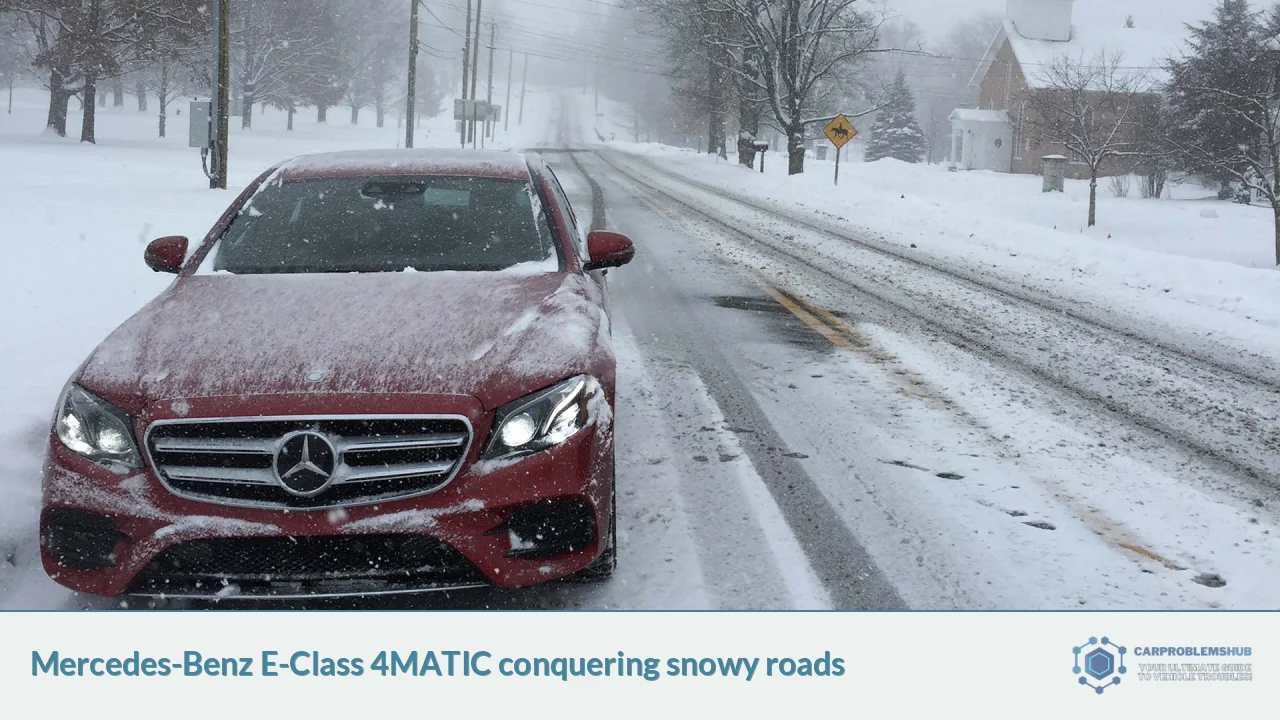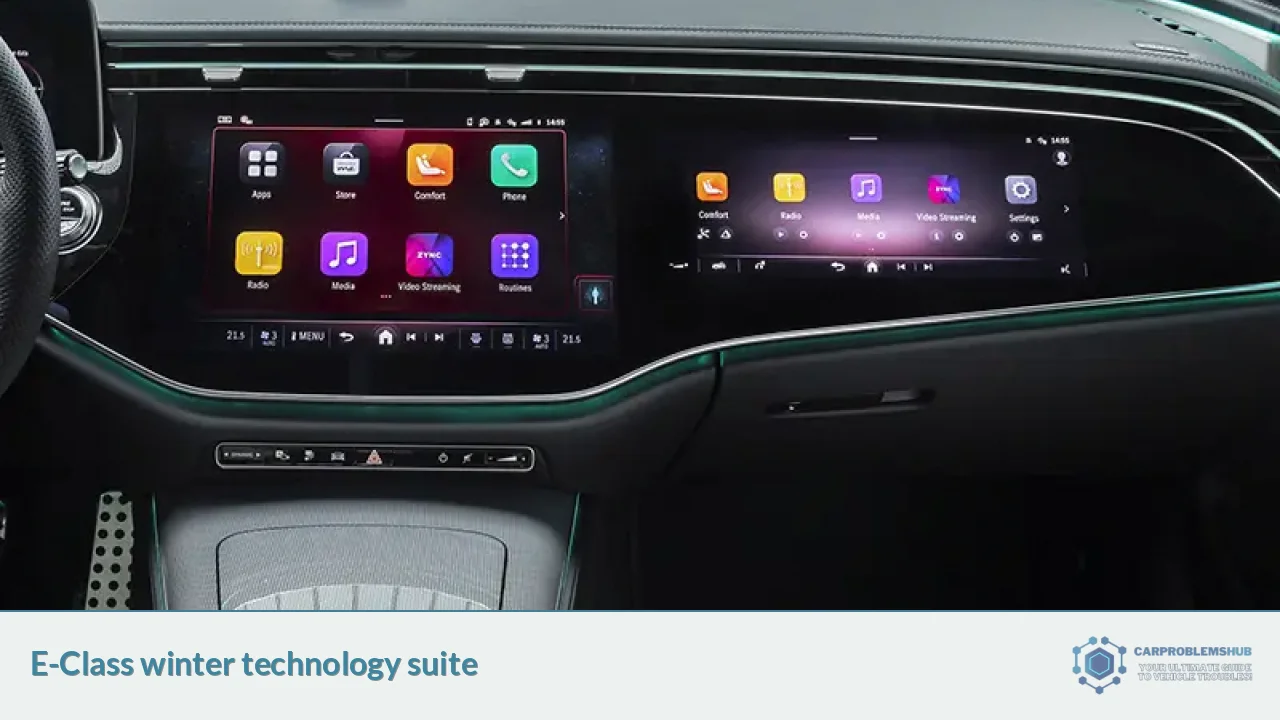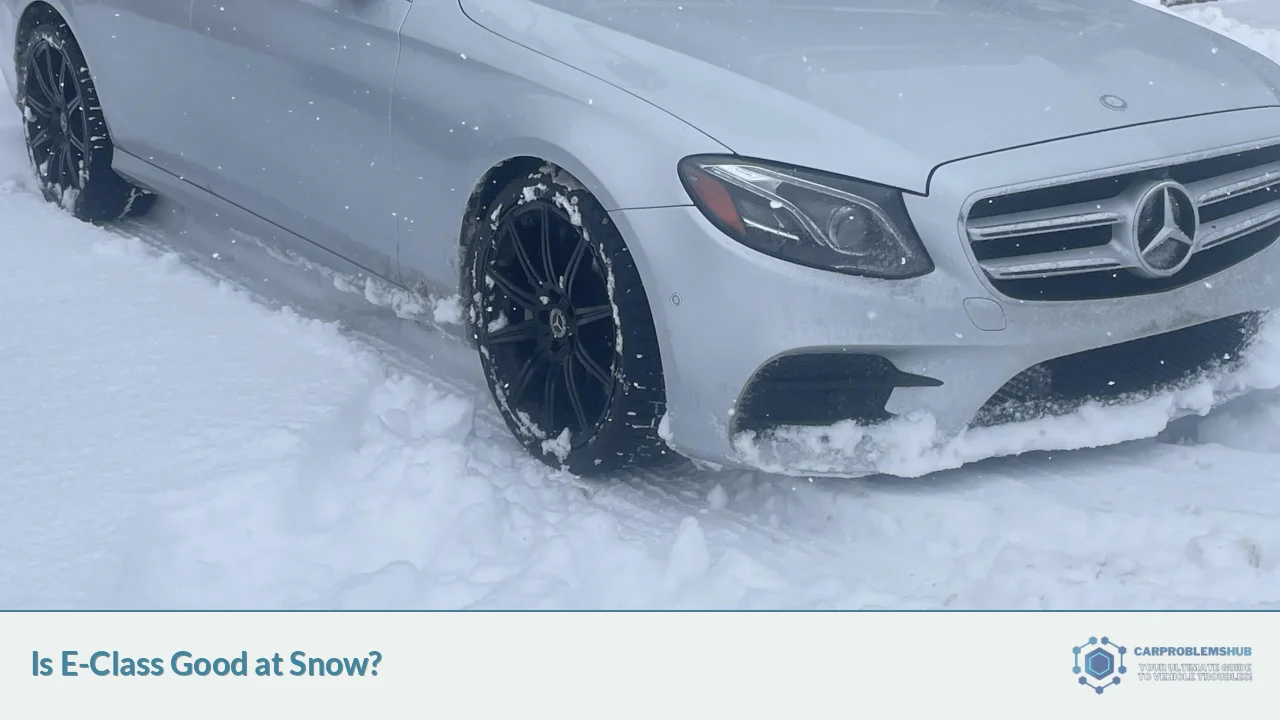The Mercedes-Benz E-Class is generally very capable in snowy conditions, especially when equipped with all-wheel drive (4MATIC) and proper winter tires. Its advanced technology, safety features, and balanced chassis design contribute to its strong performance in winter weather.
E-Class Snow Performance Overview

The Mercedes-Benz E-Class, particularly in its 4MATIC all-wheel-drive configuration, is engineered to handle snowy conditions with confidence. Here’s a comprehensive look at its snow performance:
Key Snow-Handling Features
- 4MATIC All-Wheel Drive: Provides excellent traction by distributing power to all four wheels[1]
- Electronic Stability Program (ESP): Detects and corrects wheel slippage to maintain vehicle stability[2]
- Advanced Traction Control: Optimizes grip on slippery surfaces
- Winter Driving Mode: Adjusts vehicle systems for enhanced snow performance
Performance in Various Snow Conditions
The E-Class demonstrates impressive capabilities across different snow scenarios:
- Light Snow: Excellent handling and stability
- Deep Snow (up to 8 inches): Navigates confidently, comparable to many SUVs[1]
- Icy Roads: Enhanced safety features provide good control
- Steep Snowy Inclines: 4MATIC system helps maintain traction on hills[6]
“The E-class doesn’t need AWD and can navigate the roadways as well as any 4-wheel drive unless the snow is actually more than 8 inches deep.”[1]
E-Class Winter Technology Breakdown

The E-Class incorporates several technologies that enhance its winter driving capabilities:
4MATIC All-Wheel Drive System
The 4MATIC system is a cornerstone of the E-Class’s snow performance. It continuously adjusts power distribution between front and rear axles, ensuring optimal traction in varying conditions[2].
Electronic Stability Program (ESP)
ESP monitors vehicle dynamics and can apply individual wheel braking to maintain stability. In snow, this system is crucial for:
- Preventing skids
- Maintaining intended direction
- Enhancing overall control
Advanced Driver Assistance Systems (ADAS)
The E-Class’s ADAS package includes features particularly useful in winter conditions:
- Adaptive Cruise Control: Maintains safe distances on slippery roads
- Lane Keeping Assist: Helps prevent unintended lane departures on snow-obscured roads
- Automatic Emergency Braking: Provides additional safety in low-traction situations
Winter-Specific Comfort Features
For enhanced winter comfort, the E-Class offers:
- Heated steering wheel
- Heated armrests
- Heated seats
- Powerful climate control system
“In Comfort mode, when accelerating from a stop in a hurry, the car felt slower to respond than desired. In most situations, however, the starter-generator’s electric motor assist helps to launch the E350 so that when peak engine torque arrives at 2,000 rpm, the overall impression is smooth and swift acceleration.”[4]
E-Class Models and Their Snow Performance
Different E-Class models offer varying levels of snow performance:
E350 4MATIC
- Engine: 2.0L turbocharged 4-cylinder
- Power: 255 hp and 295 lb-ft of torque
- Snow Performance: Very good, with standard AWD
E450 4MATIC
- Engine: 3.0L inline-6 turbocharged
- Power: 375 hp and 369 lb-ft of torque
- Snow Performance: Excellent, with more power for challenging conditions
Both models feature 48-volt mild-hybrid technology, which can provide additional torque for smoother starts on slippery surfaces[4].
Real-World Snow Performance
User experiences and expert reviews consistently highlight the E-Class’s strong snow performance:
“This is the 2018 Mercedes Benz E Class E300 4MATIC in the snow review Snow Drive. In this video the conditions are Hazardous with alot of snow fall, I asked to test this car in the snow because the original review did so well.”[6]
Key observations from real-world testing include:
- Stability: Excellent balance and control on snow-covered roads
- Traction: Consistent power delivery without excessive wheel spin
- Comfort: Maintains a smooth ride even in harsh winter conditions
- Confidence: Drivers report feeling secure and in control
Comparing E-Class Snow Performance to Competitors
When compared to its luxury sedan competitors, the E-Class holds its own in snow performance:
| Model | Snow Performance | Key Features |
|---|---|---|
| Mercedes-Benz E-Class | Excellent | 4MATIC AWD, Advanced ESP |
| BMW 5 Series | Very Good | xDrive AWD, Dynamic Stability Control |
| Audi A6 | Excellent | quattro AWD, Advanced Traction Control |
The E-Class’s balanced approach to performance and luxury makes it a top contender for winter driving in its class.
Maximizing E-Class Snow Performance
To get the best snow performance from your E-Class:
- Install Winter Tires: Critical for optimal traction and handling
- Use Snow Mode: Activates winter-specific vehicle settings
- Maintain Proper Fluid Levels: Ensures all systems function optimally
- Regular Maintenance: Keeps the vehicle in top condition for winter challenges
- Practice Winter Driving Techniques: Gentle inputs and increased following distances
Potential Limitations in Extreme Conditions
While the E-Class excels in most winter conditions, it’s important to note potential limitations:
- Very Deep Snow (over 8 inches): May struggle due to lower ground clearance compared to SUVs[1]
- Extreme Ice: All vehicles, including the E-Class, have limitations on sheer ice
- Steep, Unplowed Roads: May face challenges in very severe conditions
Cost Considerations for Winter E-Class Ownership
Owning an E-Class for winter use comes with specific cost factors:
- Winter Tires: $800 – $1,200 per set
- AWD Fuel Economy Impact: Slightly lower MPG compared to RWD models
- Winter Maintenance: Additional services may be required
However, the enhanced safety and performance often outweigh these costs for many owners.
Conclusion: E-Class Snow Capability
The Mercedes-Benz E-Class, especially in its 4MATIC configuration, proves to be highly capable in snowy conditions. Its combination of advanced all-wheel-drive technology, sophisticated traction control systems, and winter-specific features make it an excellent choice for luxury sedan buyers who frequently encounter winter weather.
While it may not match the extreme capabilities of some SUVs in very deep snow, for the vast majority of winter driving scenarios, the E-Class provides a balanced mix of performance, safety, and comfort. With proper tires and maintenance, it stands as a top performer in its class for snow handling.
Ultimately, the E-Class offers winter drivers a vehicle that doesn’t compromise on luxury while providing the confidence and capability needed to tackle snowy roads with ease.
FAQs
- Is the Mercedes E-Class good in snow without 4MATIC?
While rear-wheel drive E-Class models can handle light snow with winter tires, 4MATIC significantly improves snow performance and is recommended for frequent winter driving. - How does the E-Class compare to Mercedes SUVs in snow?
The E-Class performs well in most snow conditions, but SUVs like the GLE or GLC may have an advantage in very deep snow due to higher ground clearance. - Are winter tires necessary for the E-Class in snow?
Yes, winter tires are strongly recommended for optimal snow performance, even with 4MATIC all-wheel drive. - Can the E-Class handle mountain driving in winter?
With 4MATIC and proper tires, the E-Class is capable of handling most mountain winter driving conditions safely. - Does the E-Class have a specific snow driving mode?
Many E-Class models feature a “Slippery” driving mode that optimizes vehicle settings for snowy and icy conditions.
Was this page helpful?
Citations:
- 1. https://forums.edmunds.com/discussion/7326/mercedes-benz/e-class/how-does-the-rwd-e-class-handle-in-the-snow
- 2. https://www.huskermercedes.com/blog/2019/september/20/do-mercedes-benz-vehicles-drive-well-in-the-snow.htm
- 3. https://www.reddit.com/r/whatcarshouldIbuy/comments/5mniir/is_a_2014_mercedes_e350_4matic_a_good_car_for/
- 4. https://www.capitalone.com/cars/learn/finding-the-right-car/2024-mercedesbenz-eclass-review-and-test-drive/3147
- 5. https://www.jdpower.com/cars/expert-reviews/2024-mercedes-benz-e-class-review
- 6. https://www.youtube.com/watch?v=XkatG6y13cU


Similar Problems in Other Models
Porsche Macan Problems
2007 Ford Fusion Problems
2012 Toyota Sienna Problems
2013 Lexus Gs 350 Problems
2013 Audi A4 Problems
2023 Nissan Rogue Problems
2003 Buick Century Problems
2021 Tahoe Diesel Problems
2023 Kia Sorento Problems
2007 Mercedes E350 Problems
Car News and Reviews
Would you like to take a look at the car news and reviews we have carefully selected and published for you?
2024 Lucid Air Prices Go Down
GM's Big Road Network for Hands-Free Driving
DTC C0561-71 Vacuum Sensor Code on GM, GMC and Chevy
C1201 Code Toyota and Lexus (Causes and Solutions)
Chrysler Auto Start Stop Warning Light (Causes and Solutions)
2024 Ford Mustang GT: Digital Age Meets Classic Power
The 2024 Chevrolet Silverado 2500HD ZR2: An Off-Road Marvel
2024 Chevy Colorado ZR2 Bison: The Ultimate Off-Road Experience
The 2024 Lucid Air Sapphire Track Drive Experience
2024 Subaru Forester Review, Specs, Price, Release Date